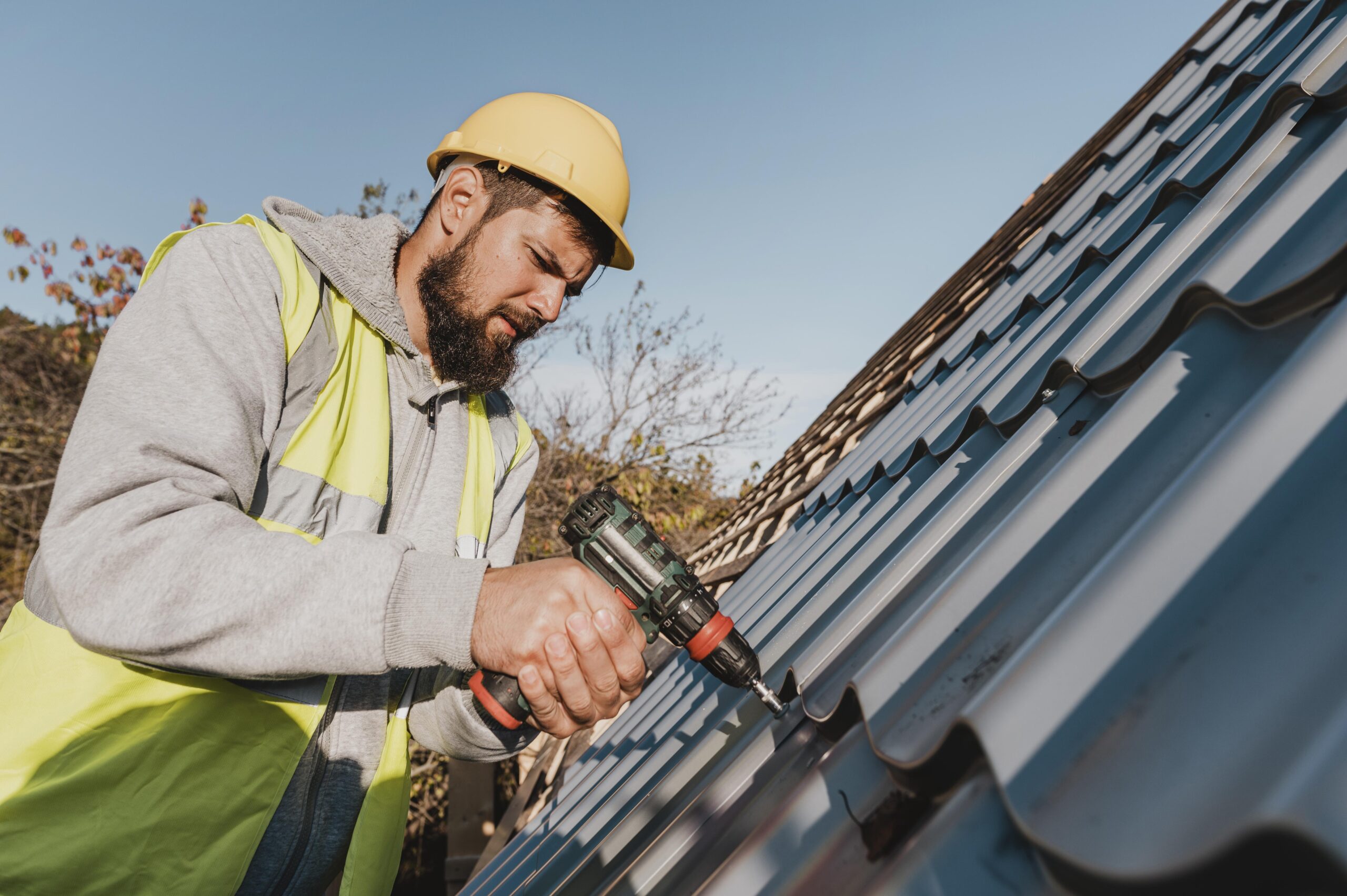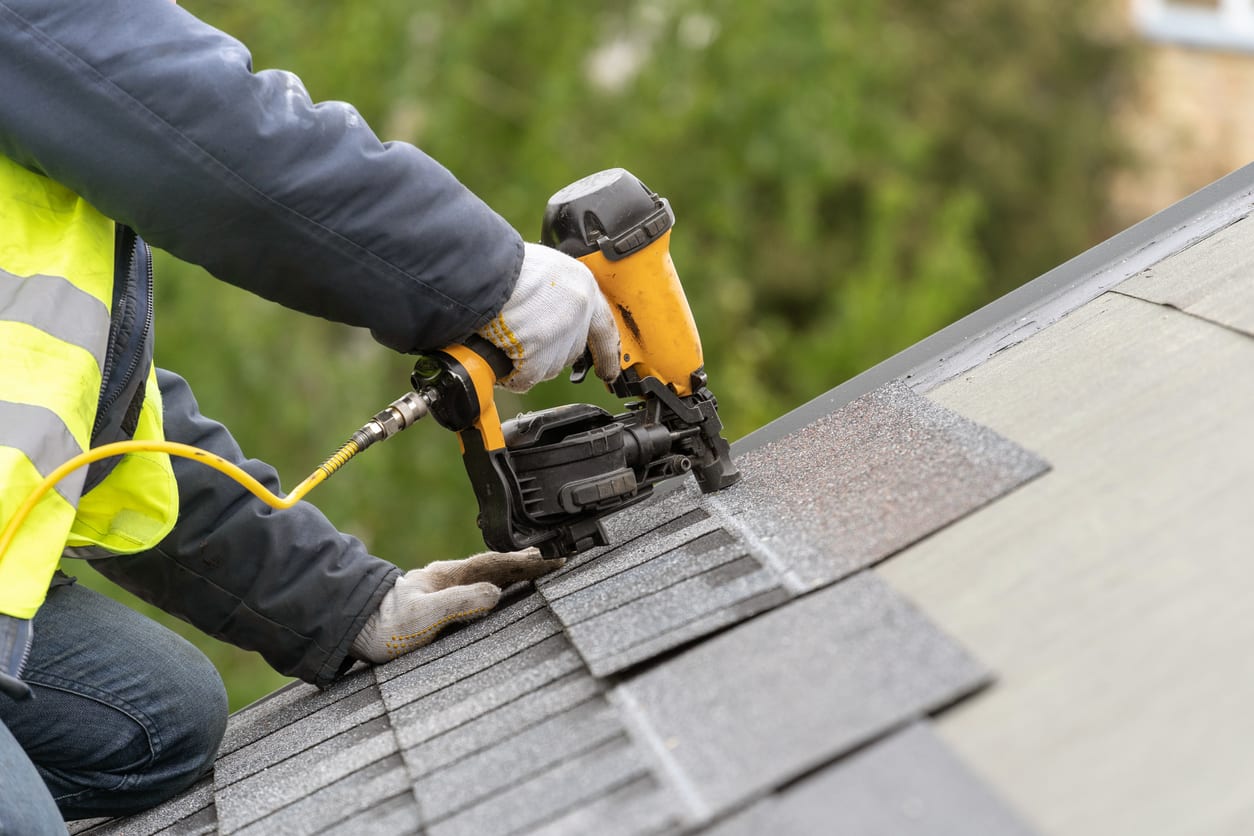Seasonal Roofing System Fixing Checklist: Prepare Your Roof Covering for each Climate
By following a seasonal roof fixing list, you can remain in advance of potential problems. Allow's check out how correct maintenance can secure your home and expand your roofing's life-span.
Evaluating Your Roof Covering for Winter Months Readiness
As winter approaches, it's vital to inspect your roof covering to validate it can withstand harsh weather. When snow and ice gather, Begin by examining for missing or damaged tiles; also a small concern can lead to considerable leaks. Next, analyze the flashing around chimneys and vents-- this location is frequently prone to water breach.
Don't neglect to look for indicators of sagging or unequal surface areas, as these may indicate architectural troubles. In addition, validate your gutters are clear; clogged rain gutters can bring about ice dams that harm your roof.
 roof repair
roof repair
Springtime Cleansing: Clearing Particles and Checking for Damages
As soon as winter's hold launches, it's time to deal with springtime cleaning on your roof covering by removing away debris and looking for any damage. Begin by inspecting your roof for fallen branches, leaves, and other particles that can catch wetness and cause rot. A tidy roof covering advertises far better drain and stops mold and mildew growth.
Next, get a strong ladder and meticulously inspect tiles for splits or missing out on pieces. Focus on areas around chimneys and vents, as these places are vulnerable to leaks. Do not forget to analyze your rain gutters, guaranteeing they're devoid of obstructions that could cause water pooling.
While you're up there, look for indicators of wear, like corrosion on metal flashing or loose seals around skylights. Resolving them currently can conserve you from costly repair work later on if you identify any kind of problems. A little springtime cleansing goes a lengthy means in maintaining your roof's stability.
Summer Season Heat: Analyzing Your Roof Covering for Heat-Related Issues
As summertime warmth heightens, it's necessary to evaluate your roof for heat-related problems. Look for any kind of roof shingles damage, look for indications of warmth fastening, and review just how well your roofing system ventilates. Taking these steps currently can stop larger issues down the road.
Examine for Tile Damages
 roof repair
roof repair
Examine for Warm Buckling
Warmth buckling is an usual issue that can arise throughout the scorching summertime, and it's necessary to look for it on your roofing system. As temperatures rise, roofing products, especially asphalt shingles, can broaden and contract. This motion can cause warping, producing unattractive lumps or splits. Begin by examining your roof visually; try to find any type of uneven surface areas or lifted sides. Pay unique focus to areas around chimneys and vents, where buckling is more probable to occur. If you find any indications of warm fastening, it's crucial to resolve them quickly to avoid more damage. If you're not sure concerning the degree of the concern or exactly how to fix it properly., consider consulting an expert.
Review Roof Ventilation Performance
After looking for warmth buckling, it's vital to examine your roof's ventilation performance. Appropriate air flow assists manage temperature and moisture, protecting against damages from too much heat. Beginning by examining your vents; make certain they're not blocked by debris or insulation. Seek indicators of poor air flow, like warmth build-up in your attic or distorted roof covering materials. You could likewise intend to check if your soffit vents and ridge vents work with each other effectively. If your home really feels stuffy and overheated, take into consideration upgrading to much more efficient air flow systems, like powered attic followers or additional soffit vents. Keep in mind, maintaining great air flow not only prolongs your roofing system's life however also improves your home's total power performance, ensuring convenience throughout those hot summer season.
Rainy Period Readiness: Making Certain Correct Water Drainage
As the rainy period strategies, you require to ensure your roofing's drain system prepares to manage heavy rainstorms. Start by evaluating your downspouts and rain gutters, and ensure they're free from debris. Don't neglect to inspect the blinking and seals to protect against leakages and water damage.
Examine Downspouts and rain gutters
During the wet season, it is important to frequently examine your downspouts and rain gutters to guarantee proper water drainage. Start by inspecting for any kind of visible particles, like branches or leaves, that could block the circulation of water. Make certain the seamless gutters are securely affixed and devoid of drooping, as this can catch water and bring about leaks. Next, analyze the downspouts for blockages or damages; an obstructed downspout can cause water to overflow, possibly harmful your roofing system and structure. Validate that downspouts straight water away from your home's foundation. If you spot any concerns, address them promptly to avoid costly repair work. A little maintenance currently can save you big migraines later when heavy rains struck.
Tidy Roof Surface Debris
Utilize a roof rake or broom to gently get rid of particles, being cautious not to damage the roof shingles. After cleansing, monitor your roofing system after heavy rainfalls to detect any type of prospective problems early. Maintaining your roof clear of particles is essential for avoiding costly fixings down the line.
Check Flashing and Seals
After clearing your roof of debris, take a better look at the flashing and seals around smokeshafts, skylights, and vents. These locations are essential for preventing leaks throughout the rainy period. Examine the flashing for any type of signs of corrosion, cracks, or voids. It's essential to repair or replace it quickly if you observe any kind of damage. Next, inspect the seals; they should be limited and undamaged. Try to find any type of peeling or damaged areas that might permit water to permeate in. Take into consideration resealing them with a high-grade roofing sealer if you find any kind of jeopardized seals. Making sure these components are in great problem will certainly assist keep proper drain and secure your home from water damage during heavy rainfall.
Checking and Maintaining Roofing Seals and Flashing
While it may seem very easy to forget, preserving and examining roofing system seals and blinking is crucial for stopping leaks and water damage. Start by evaluating the seals around smokeshafts, vents, and skylights. Try to find any type of fractures, voids, or indicators of wear. It's ideal to reseal them with ideal roofing sealer to ensure a tight fit. if you identify any type of concerns.
Next, take a look at the flashing, which guides water far from essential areas. Look for rust, loosened areas, or bent edges. Change it or secure it effectively to keep its integrity if you discover any broken blinking. Remember, even a small flaw can cause significant issues down the roadway.
Lastly, do not forget to wipe any kind of debris that may obstruct the seals or blinking. Keeping these elements healthy will assist safeguard your roofing versus the components and expand its lifespan.
Rain Gutter Maintenance: Keeping Water Moving Smoothly
Since your seamless gutters play an essential duty in routing rain away from your home, regular upkeep is vital for preventing water damage and foundation problems. Beginning by removing out particles like fallen leaves, twigs, and dust. A stopped up rain gutter can lead to water overflow, which might damage your roofing and house siding. Utilize a tough ladder to get to the seamless gutters securely, and use gloves to shield your hands.
If you see any kind of damages, repair work or change the damaged parts quickly. Verify downspouts are directing water at least six feet away from your structure.
Finally, examine that your seamless gutters are appropriately sloped, preferably a quarter inch for each 10 feet. This slope warranties water flows smoothly towards the downspouts. Regular maintenance will keep your rain gutters operating successfully and safeguard your home from costly repair services.
Setting Up Expert Evaluations for Comprehensive Treatment
Routinely organizing professional inspections is vital for maintaining your roofing system's stability. This timing allows you to deal with any type of damages triggered by winter months weather or summer storms.
Throughout assessments, professionals will certainly examine roof shingles, flashing, and ventilation, guaranteeing every little thing's in leading shape. They'll also examine for signs of wear, leaks, or mold and mildew, which you could ignore. Scheduling these assessments not just prolongs your roof covering's life-span yet also provides you satisfaction.
If you're uncertain about the condition of your roofing system, don't wait to call a specialist. Buying these examinations currently can conserve you a whole lot later on. Prioritize your roof covering's health and wellness, and you'll be well-prepared for whatever weather comes your method.
Frequently Asked Inquiries
How Typically Should I Inspect My Roof Throughout the Year?
You should evaluate your roof a minimum of twice a year, preferably in springtime and autumn. After serious climate occasions, check for damages also. Routine inspections assist you capture problems early and save money on repair services.
What Indications Show I Need a Roofing Replacement Instead of Repair?
 roof repair
roof repair
Can I Carry Out Roof Covering Services Myself, or Should I Work with an Expert?
You can carry out minor roofing repairs on your own if you're comfy with elevations and standard devices, but working with a specialist assurances safety and security and correct work. Don't risk damage; it could be worth the financial investment for peace of mind.
What Are the most effective Products for Roof Repair Works in Various Climates?
For different environments, you'll want products like asphalt tiles for modest areas, steel roofing for extremes, and clay floor tiles for warm regions. Always consider local weather condition patterns to guarantee your roofing system holds up against the elements efficiently.
How Do Roof Covering Warranties Influence Seasonal Maintenance Responsibilities?
Roofing system service warranties frequently define maintenance duties, so you'll need to review the terms. If you do not preserve your roof covering as required, you might nullify the warranty, leaving you liable for expensive repair work.
Seasonal Roofing get more info Fixing List: Prepare Your Roofing System for Every Weather Condition
As soon as wintertime's hold launches, it's time to deal with springtime cleaning on your roofing by clearing away particles and examining for any type of damage. Check for any type of roof shingles damages, look for indicators of heat fastening, and evaluate exactly how well your roof aerates. If you find any concerns, consider getting in touch with an expert for fixings to maintain your roofing system in leading shape and secure your home from potential water damage.
While it might seem easy to overlook, maintaining and checking roofing system seals and flashing roof repair gainesville ga is essential for avoiding leaks and water damages.